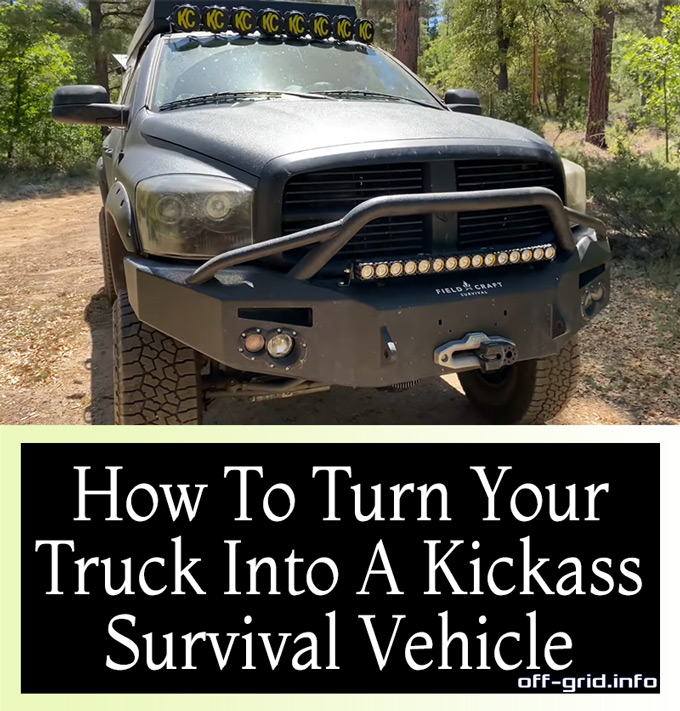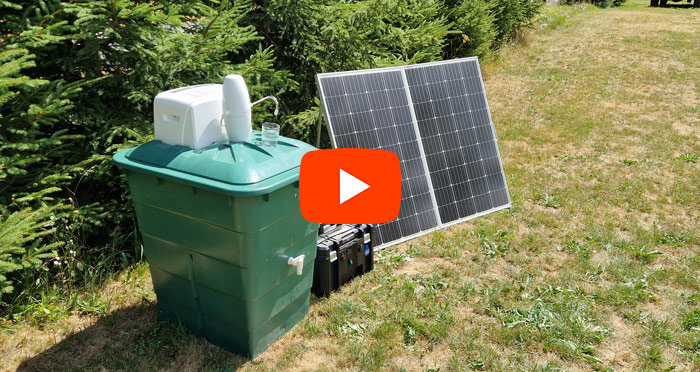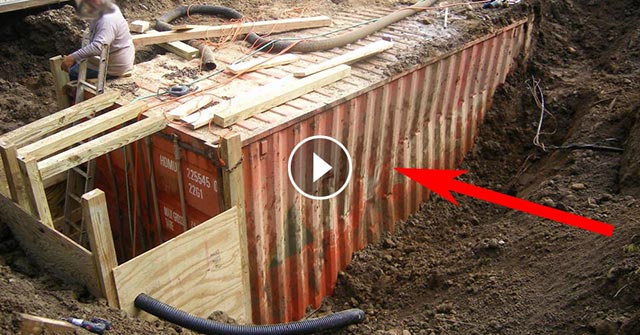Click Here To Join Our Telegram Channel for FREE daily tutorials!

How To Turn Your Truck Into A Kickass Survival Vehicle – Graphic © off-grid.info. Images: https://www.youtube.com/watch?v=obSdBLc7Niw
Mobility is critical to survival, so here’s a detailed run-down of ideas to help you get thinking about your own survival truck – whether you are starting with a vehicle you already have, or are considering picking something up.

1) Overall Considerations When Choosing A Vehicle:
An off-grid / survival truck has a unique set of requirements but these can be summarized easily:
a) Built tough AF.
b) Go anywhere – your survival vehicle should ideally have true 4WD capability, good ground clearance, strong axles and drive train, off road tires.
c) Reliable.
d) Cargo capacity.

e) Equipped with tools and equipment to provide versatility in various environments plus get you out of situations.
f) Should be easily repaired and be “not exotic” so that parts are not too difficult to obtain. Good examples might be a Toyota Hilux / Tacoma / Tundra, Land Rover, Jeep Wrangler / Gladiator, Dodge Ram 2500 or perhaps even a common military vehicle such as a MAN (though bear in mind that ex-military vehicles can have challenges when it comes to international travel due to export restrictions).
g) Comfort – can you sleep in it?
h) Security / protection – your vehicle should protect the occupants as best it can from both the elements and from hostile persons or wild animals.
2) Build:
Your rig’s ability to deal with various terrain is likely to be its #1 make-or-break characteristic.

A classic survival situation that is actually quite common – especially if you are “off the grid and off the map”: Your vehicle gets stuck. Either in mud, in a hole or run aground due to insufficient ground clearance. Expeditions into places beyond civilization encounter these kinds of scenarios all the time and if you can’t get unstuck…… it’s quite literally the end of the road. So let’s talk first about ground clearance and the components that contribute to it.
Axles: In rough terrain, tough axles are an important consideration. You want something that won’t fail when put to the test. The entire drive train needs to be built tough because as the saying goes, a chain is only as strong as its weakest link.
Lift: It’s important to get a high quality lift as budget lift work that is not as well done can put strain on the vehicle components and cause instability. A lift will give you not only better ground clearance but some added protection as it’s harder for passers by to see inside the vehicle from the outside. It also facilitates the fitting of larger wheels, which increase ground clearance still further. Mike Glover uses and recommends a lift from pureperformance.com
Wheels And Tires: Off road wheels would benefit from “All terrain” tires give a “hybrid” capability – a balance between on road and off road use. Full off-road tires will wear more quickly and not perform as well on-road. Larger wheels and tires will also give greater clearance to the axles, which on a lifted vehicle will be the lowest point of the vehicle to the ground. Spare full size tire: Don’t skimp on this, you don’t want to be stuck out in the wild with just one of those “donut tires”. Serious outback adventurers often take more than 1.
Roll cage: Designed of course to protect the occupants in the event of a rollover.
Fuel Tank: Once you run out of fuel, you’re S.O.L. If SHTF, you might not be able to get fuel at all and so you will be dependent on what you happen to be carrying. So for general survival purposes, or if you are in a rural / remote area you might do well to consider an aftermarket auxiliary fuel tank – such as those from transferflow.com or longrangeamerica.com which can significantly extend the range of your vehicle. At the very least, a high quality metal “Jerry can” or two will add some range and help you get where you need to go. Get the cans that have the heavy locking cap as they are less prone to leakage than the cheap plastic type. Example: Wavian Authentic NATO Jerry Fuel Can, Red (Amazon, rave reviews)
Snorkel: If water gets into your air intake, your engine will stall; a snorkel will increase the depth of water your vehicle can ford as well as assisting with intake of clean, cool air to the engine.
Professional Build: If you want all this done right, it makes absolute sense to go with a pro build. Searching around, lots of guys raving about the AEV (American Expedition Vehicles) Prospector XL, which is a top quality (and very expensive!) upgrade to the Dodge RAM 2500 – to include 40″ tires, heavy duty winch, off road lights and so much more. This vehicle, it is claimed, will have at least a 23″ ground clearance: Rave reviews from professionals and overlanders alike… one commenter, who claims to use it daily for tree work, calls it the “pinnacle of truck evolution”. This really is a kickass survival vehicle:
3) Front End Reinforcement:
Mike Glover covers this nicely from 1:36 onwards in this video:
If you need to ‘get out of dodge’ and ordinary roads are impassable for whatever reason, you might need to travel off road – and we don’t just mean dirt roads. We mean possibly going through fences and over obstacles of whatever kind – or perhaps pushing things out of the way. The beefier the front end of your survival rig the better. It’s #1 job is to protect the radiator, the destruction of which would incapacitate the vehicle. A stronger font end also of course gives crash protection to the occupants.
Mike goes with a front end from Fabfours.com, which also facilitates the addition of an after market light bar from rigidindustries.com and protection for the Warn winch, which allows self recovery. Let’s focus now on the winch:
4) Winch (And Related Equipment):
Hard core off-roaders and recovery professionals rely on a cable winch to solve various problems. A winch can be used to:
a) get your own vehicle unstuck (for example hook the cable to a tree and pull yourself out)
b) get someone else’s vehicle unstuck (hook the winch to their vehicle and pull them out).
c) drag large objects (for example a boulder or large log).
Winches need to be understood and used correctly and safely. Good tutorial here: https://towprofessional.com/article/winch-basics-and-not-so-basics/
If you are going to get a winch for serious jobs, you will want a “snatch block” which has been described by reviewers as “The most important slab of metal you will ever buy (besides the winch itself)”. A snatch block can be used to either reverse your pulling direction or double the strength of the pull, depending how you configure it. Here’s a link to a top quality 20,000lb snatch block which got tons of 5-star reviews on Amazon: https://amzn.to/3UlNaeB.
For example if you are in a vehicle with a 9000 pound winch and are stuck you will have 9000 pounds of pulling power by hooking directly to a tree in front of you. If, however, you put a snatch block B007JMOVSO at the tree end (with a winch strap B001CF4UXU round the tree), then run the cable through it and back to your vehicle you will then have 18,000 pounds of pulling power.
This gives you added strength when moving large logs or in any serious situation. If you are out in the mountains this could be the difference between getting home and freezing to death, no joke.
Here’s a great tutorial in how to connect and use your winching equipment properly:
“Scotches” are advisable when doing heavy winches to stop your winch vehicle being dragged backwards. Demonstration:
A recovery strap is specifically designed with a little give in it. This is because when one vehicle is pulling another out, there can be a very strong jerk as the rope goes tight. The modern generation of kinetic ropes is regarded as much safer than old-school steel cables. For serious pulling here’s a very highly rated stretch rope rated at 52,300 pounds (tons of 5 star reviews on Amazon) https://amzn.to/3OTzYws
You’ll also want a couple of D-Rings (aka D-Shackles) to complete the setup. The importance of these cannot be underestimated for vehicle recovery, indeed for most 4x4s, the D shackle is how you attach the strap to the vehicle. Here are some heavy duty D-Ring Shackles on Amazon: https://amzn.to/3XNfIk9
Safety is ABSOLUTELY paramount when using winches. Do not even attempt to use a winch unless you know what you are doing! A steel cable under heavy strain that snaps can turn into a whip that is powerful enough to kill. Seriously. The heavy object being winched could also go flying backwards or fall. A winch that has failed due to misuse could also cause the object being pulled to be suddenly released and free fall, squashing whatever is in its path. NEVER stand, walk or sit behind or below anything being winched and don’t use the equipment unless you absolutely know what you are doing.
5) GPS:
If you’re off the grid and off the map, then navigation is even more critical than it is finding your way through the streets! The navigation app on your smart phone may be good but what happens when you are out of cell phone range? Yes, your iPhone has GPS – but a dedicated satellite GPS navigator does not rely on cellular signals and is unaffected by cellular dead zones. This Garmin nüvi 55LM GPS Navigator System is the #1 seller on Amazon and gets great reviews.
6) Tool up:
Your survival vehicle should be equipped with a wide variety of tools. The list here could be as long as your arm, or your budget (and don’t forget to think about your overall pack weight) but think about what truckers and military folks carry with them. Basic mechanic tools, jacks and vehicle repair kit, bridging ladders, inverter, battery power tools such as a reciprocating saw with branch cutting blades (this is very valuable in forest regions. I once was able to clear a 6″ small tree that had fallen across a road and be on my way because I happened to have one of these in the trunk!)
Stow some heavy work gloves on the truck and leave them there. You will be glad you did!
Pro tip: pack a 12″ square of 1″ thick plywood to use as a base for a wheel jack. Jacking a vehicle on even slightly soft ground can be hazardous as if the jack sinks it can collapse, with the vehicle crashing down suddenly and without warning. I’ve seen this happen and it’s bad news.. it can of course be catastrophic if you are under the vehicle doing a repair.
7) Essential Supplies:
You can survive several days without food. Without water, you are in trouble much, much faster. A supply of clean, potable water is an absolute essential if you are anywhere that fresh water on tap is not a given. A sterile 5 gallon water container will keep you going for a few days. At the very least pack a couple of 1-gallon containers. These are useful for refilling a radiator after the event of an overheat also.
8) Electrical Power Rigs / Upgrades For Off Grid And Survival Vehicles.
A vehicle makes an ideal power plant for a wide variety of uses. The alternator on a vehicle is essentially a powerful generator that can be used to charge batteries. Batteries can then be used to power DC appliances or run to an inverter that will deliver AC power to run various electrical equipment that you already have. Once you have a good power setup, you have essentially unlimited options.
Batteries also give the option of DC charging from solar panels and a variety of other sources – giving you versatility and an almost ideal power supply that can be used “anywhere”.
Such a system requires significant knowledge to assemble correctly. Here are some of the of the basics.
8A) INVERTERS
A powerful inverter can be connected (using short cables) to the vehicle battery and then with the engine running, regular 110/240v AC power tools and various appliances can be connected. I’ve used a 2300w Power Bright Inverter B002AMPGE6 connected to a truck to run a sump pump and drain a flooded area, small electric heaters and all kinds of power tools. Connect the inverter using short, thick jumper cables, start the engine (so as not to drain your battery!), flip on the inverter power and off you go.
In order to run sensitive electronics and in fact to prolong the life of equipment of all kinds, you will want a pure sine wave inverter (as opposed to a modified sine wave inverter). These produce much cleaner power. My inverter of choice is the Xantrex PROWatt 2000 which is rated to kick out 1800w pure sinewave, clean power. More than 2000w pure sine inverters start to get expensive but are essential if you want to run more powerful appliances. Modified sine units are much cheaper but I don’t use them as I don’t want to risk damaging my equipment. Some sensitive equipment will not even run from a modified sine inverter.
Be wary of cheapie brands of inverter! There are a ton of these out there and you will probably get what you pay for. I located what looks to be a kickass 2000w inverter at a decent price – the AIMS Power PICOGLF20W12V120VR – which got an almost “perfect score” string of 5-star reviews. That’s really unusual for an inverter as (to be honest) even with great inverters there is always some jackass who wired it incorrectly and finds it shuts down every time under load. Anyway one reviewer wrote of the AIMS – “I have operated the refrigerator, a small microwave, several electric lights, heating circulator fans, and the washing machine… All simultaneously…. it has delivered way beyond my expectations.”
The AIMS promises to deliver 6000 watt peak power for 20s – which should be able to handle the inrush current required by appliances such as air conditioning, circular saws and other power tools. This unit looks to be a true piece of off grid tech worthy of consideration. You might need the 4000w or 6000w model to run an air compressor as they have a large spike on switch-on.
8B) BATTERIES
In order to handle heavy demand, high power inverters require high-capacity battery banks. For serious use a separate deep cycle battery bank is advised, with various options for charging from connection through to the regular battery through to solar panels. Such installations are best done by a pro or someone who really knows what they are doing. DC power can be dangerous and a short can carry enough current to make wires glow white hot, slough off their insulation in seconds and start a fire very fast. You’ll want an inline fuse on the DC supply that is designed to protect you from this kind of short – and the fuse needs to be correctly rated for the current you are drawing. Also these batteries can be extremely heavy and lifting them can be dangerous if done incorrectly.
8C) CABLES
In order for the juice to make it from the batteries to the inverter and supply the required power safely, very low resistance wiring (read: short, thick cables) and high-quality connections are required.
Beef up your DC cables! DC power does not hold its voltage over distance in the same manner as AC power. There’s a formula for running DC cables to the inverter and if you look at the inverter, you will see connectors designed for “monster cables” – sometimes going to 0AWG and even beyond. You want the beefiest cables that you can physically connect. Double them up if you can – and run the shortest distance you possibly can from your batteries to your inverter.
AWG stands for “American Wire Gauge” and is the standard wire size measurement system in the USA. [expand]
Here’s some 2/0 AWG cables which should be sufficient for 175-amp and 200-amp fuses. For a 6000w inverter, something of the order of these monster 4/0 inverter cables would be advisable (listing states use up to 7000w inverters). Bigger cables than that I have never seen.
In the past I have built “power boxes” which have a battery compartment and then the inverter sits right on top or on the side, enabling the shortest possible cables to be run.
Only if the cable is beefy enough will you get the unit to deliver its rated power without shutdown. The longer and/or thinner the cable run, the harder it is for the battery to push what is required. Thinner cables also get hotter (think about a lightbulb filament to understand this concept) – which can be dangerous.
8D) CONNECTORS
Even a great cable can fail to deliver if the connectors used are inferior. Good, solid, tight connections are ideal to prevent resistance.
Even worse, it could come disconnected, leaving one with a potentially hazardous situation of a massive current cable “on the loose”. If a positive connector were to work loose and touch a ground point, it could immediately start a fire.
I would advise to purchase well-made cables with the connector lugs already fitted.
8E) RELAY / ISOLATOR
This super-useful component enables you to isolate correctly a second battery from the main system and switch it back into the system as required.
Here’s a highly rated example from Amazon: https://amzn.to/3H4cB1w
LEARN MORE
I could go on forever (can you tell I love this topic?) but I’ve pulled out an additional collection of some of the best videos I found of folks giving us a rundown of their survival rigs. Watching these videos will give you a ton of additional ideas and insight. Enjoy:

This Crazy Off Grid Device Literally Makes Drinkable Water From Fresh Air:
According to NASA, the U.S. is expecting a 100-YEAR LONG MEGADROUGHT.
It's already begun. Ask the farmers in California. They know.
Every survivalist knows that water is of critical importance. You NEED an independent water source that you can count on!
As an interesting "survival rehearsal" - imagine that you turned the tap on right now and nothing came out. How long would you last?
But what if there was another water source literally hidden in plain sight. That's right, I'm talking about the atmosphere!
The amazing thing about getting water from the natural moisture in the air... is that it is ALWAYS available.
This gives you real water security!
Learn more about how to tap into "Nature's secret water reservoir" and stay hydrated when TSHTF!
Watch the video:
😳 What Tinnitus Does To Your Brain Cells (And How To Stop It)
After 47 years of studies and countless brain scans done on more than 2,400 tinnitus patients, scientists at the MIT Institute found that in a shocking 96% of cases, tinnitus was actually shrinking their brain cells.
As it turns out, tinnitus and brain health are strongly linked.
Even more interesting: The reason why top army officials are not deaf after decades of hearing machine guns, bombs going off and helicopter noises…
Is because they are using something called "the wire method", a simple protocol inspired by a classified surgery on deaf people from the 1950s...
Most People Don't Have The Guts To Try This:
An amazing discovery in an abandoned house in Austin, Texas: A lost book of amazing survival knowledge, believed to have been long vanished to history, has been found in a dusty drawer in the house which belonged to a guy named Claude Davis.
Remember... back in those days, there was no electricity... no refrigerators... no law enforcement... and certainly no grocery store or supermarkets... Some of these exceptional skills are hundreds of years of old and they were learned the hard way by the early pioneers.
>> Click here to find out about them now
We've lost to history so much survival knowledge that we've become clueless compared to what our great grandfathers did or built on a daily basis to sustain their families.
Neighbors said that for the last couple of years Claude has tried to unearth and learn the forgotten ways of our great-grandparents and claimed to have found a secret of gargantuan proportions. A secret that he is about to reveal together with 3 old teachings that will change everything you think you know about preparedness:
>> Click Here To Watch The Video <<
What REALLY Happens When You Bury a Shipping Container? (Hint: It's A Bit Crazy...)
Shipping containers are all the rage - but if you are thinking about buying one, you MUST watch this video first:
Do not, I repeat do NOT do what these lunatics did! Can you spot the "fatal mistake" they made?
There's a general belief that if you bury a shipping container you can create an awesome root cellar / storm shelter / survival bunker.
But is a shipping container strong enough to handle the pressure?
Watch the video to see what happens:
What Really Happens When You Bury a Shipping Container? (Click To Watch Video)

I Can't Help Showing This Off:
If you haven't heard of Claude Davis yet do yourself a huge favor and watch this video.
One of the smartest guys I ever had the pleasure of meeting, Claude set-up a unique prepping system that changed his life forever.
I already tried it myself and let me tell... you I was completely blown away... His surprising tactics could make your life easier and give you the peace of mind you deserve.
Don't just take my word for it... watch his short video and decide for yourself.
>> Click Here To Watch The Video <<

More Off-Grid And Survival Resources:












